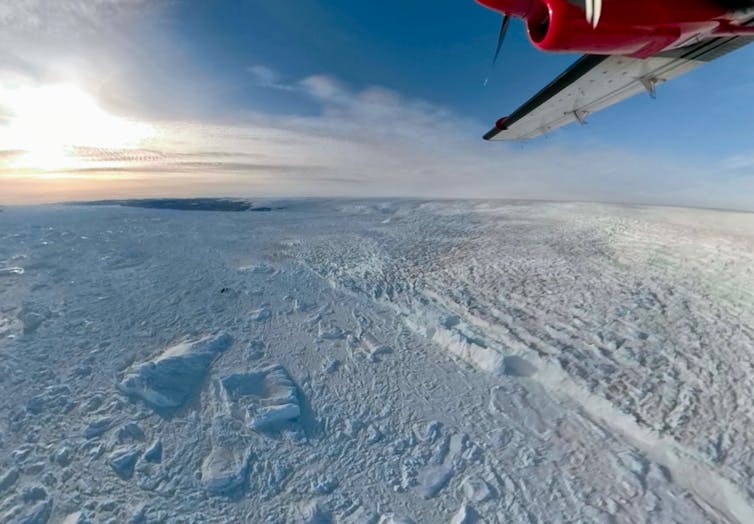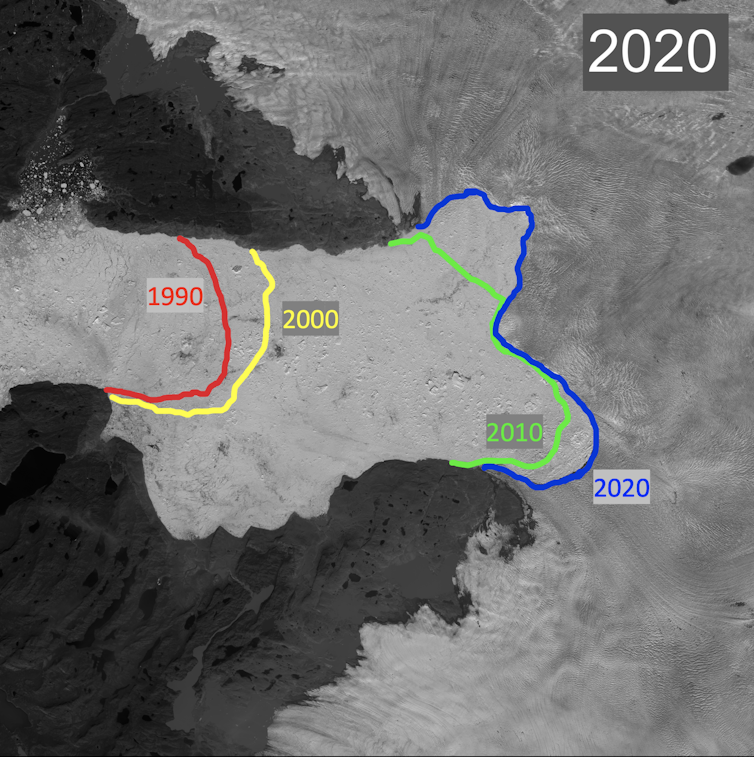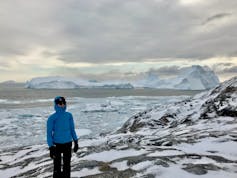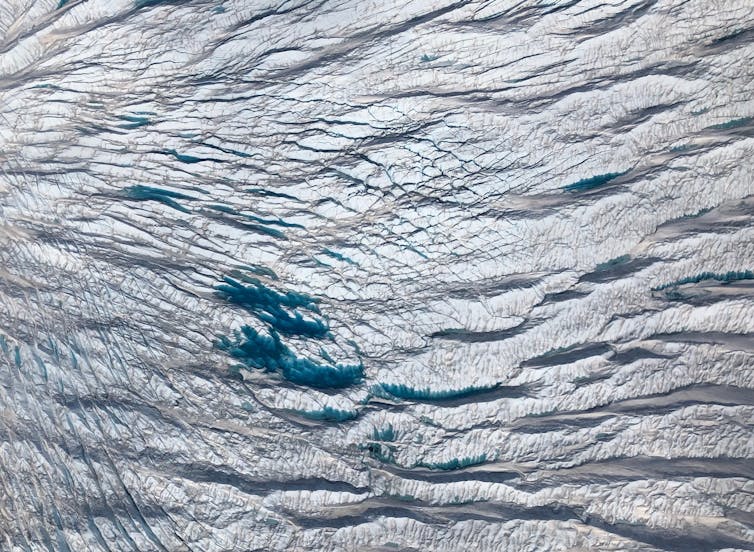Michalea King, The Ohio State University
Greenland is the largest island on Earth, and about 80% of it’s coated by a giant sheet of ice. Slowly flowing glaciers join this large frozen reservoir of contemporary water to the ocean, however due to local weather change, these glaciers are quickly retreating.
I’m an earth scientist who research how modifications to Greenland’s glaciers have an effect on the stability of the ice sheet as a complete. Healthy glaciers are secure in measurement and form and act as drains for the ice sheet, transporting ice into the sea. They keep a stability the place the ice added every year roughly equals the ice misplaced to the sea.
But due to warming brought on by local weather change, that dynamic has modified.
For years, scientists have watched as glaciers round the world retreat. But our analysis has discovered that the glaciers alongside the fringe of Greenland have retreated a lot that they now not keep the ice sheet that feeds them in balance.
As the glaciers retreat up valleys, they movement quicker and convey extra ice from inland to the sea. Imagine a site visitors jam: When a freeway is jampacked with automobiles – or ice – it flows slowly. But as the jam or glacier will get smaller, the variety of automobiles, or the quantity of ice, that may movement by in a given time will increase.
Greenland’s ice sheet is now out of stability. The new normal is an annual overall loss of ice.

Changes at the edge, penalties for the complete
Ice sheets are shaped when snowfall accumulates over hundreds of years and compresses into layers upon layers of ice. But ice just isn’t a completely inflexible materials – it behaves sort of like an extra-thick yet brittle honey.
Once an ice sheet turns into tall sufficient, the ice begins to movement outward due to its personal weight. This ice is funneled down valleys towards the ocean, forming quick–flowing outlet glaciers. These glaciers can transfer as a lot as 10 miles per yr.
Although glaciers comprise solely a slim area at the fringe of the ice sheet, they play a big position in controlling how quickly ice is drained from the sheet into the ocean. Generally, a glacier that extends a lengthy distance via a valley will move more slowly and drain much less ice from the ice sheet than if it have been shorter.
Most of Greenland’s glaciers finish at the sea, the place ocean water melts and weakens the ice till it breaks off in items that dramatically fall into the North Atlantic. If ice is misplaced at the entrance of the glacier quicker than it’s replenished by upstream ice, the glacier will recede inland. This known as glacial retreat.
Retreat not solely shortens the size of the glacier but in addition reduces the friction between the ice and surrounding valleys. With much less floor space of ice touching the floor, the ice can movement quicker. Much like a shrinking site visitors jam, sustained glacier retreat leads to faster-flowing glaciers that drain the ice sheet above more rapidly.

A persistent state of loss
Ocean and air temperatures have robust results on glaciers. Both ocean and air temperatures are rising.
For Greenland’s glaciers, the warming ocean is the largest reason behind glacial retreat. On common the glaciers have retreated about 3 kilometers since the mid-1980s, with most of this retreat occurring between 2000 and 2005.
My colleagues and I used hundreds of satellite tv for pc photos to measure modifications in size, thickness and movement velocity of Greenland’s glaciers. With this data, we discovered two essential issues: Glacial retreat is accelerating, and the ice sheet is dropping an astonishing – and likewise growing – quantity of ice every year.

Our workforce discovered that at the moment, the glaciers drain 14% more ice from the ice sheet annually – roughly 500 billion metric tons – than they did on common between 1985 and 1999. This quicker movement is inflicting the ice sheet that covers most of Greenland to shrink, however it has additionally modified the dynamic of the whole system.
The ice sheet is now in a new, unbalanced state of persistent mass loss. Before the yr 2000, ice loss roughly equaled the ice added from snowfall, so the ice sheet was secure. Now, ice mass losses constantly exceed mass positive factors – even in the coolest years of comparatively excessive snow accumulation. The glaciers used to behave as an essential site visitors jam, preserving ice loss in verify. Now, nevertheless, site visitors flows extra freely and the ice is ready to extra simply movement away from the ice sheet.
Unfortunately, hotter air temperatures have additionally increased surface melt, leading to much less snow now accumulating on Greenland. Given all these elements, my colleagues and I now estimate that the ice sheet might even see a mass achieve yr only once a century.

In severe hassle, however not but doomed
Our research confirmed how widespread retreat drove each a rise in glacier discharge and a shift to persistent ice sheet mass loss. But this doesn’t imply the ice sheet is doomed. Continued retreat and additional will increase in discharge are restricted by topography.
[Deep knowledge, daily. Sign up for The Conversation’s newsletter.]
Over the subsequent a number of centuries, the glaciers could retreat onto greater floor and finally kind a fully landlocked ice sheet with minimal flow – primarily a massive chunk of ice sitting on high of Greenland with no glaciers to empty it. Under this future situation, the stability of the ice sheet could be decided solely by floor modifications – snow accumulation and floor soften. This loss of ice would equal meters of sea level rise.
At this level, the destiny of the ice sheet merely depends upon whether or not it’s melting quicker than it grows from snowfall. In a heat world the place local weather change just isn’t addressed, the ice sheet will slowly soften and in the end disappear. But if local weather change is managed and cooler temperatures are maintained for a extended interval, it’s doable that the Greenland ice sheet may regrow. That day could also be a whole lot of years into the future, however it’s actions made at the moment that may resolve the destiny of Greenland’s ice sheet.
Michalea King, Postdoctoral Climate Science Researcher, The Ohio State University
This article is republished from The Conversation below a Creative Commons license. Read the original article.







